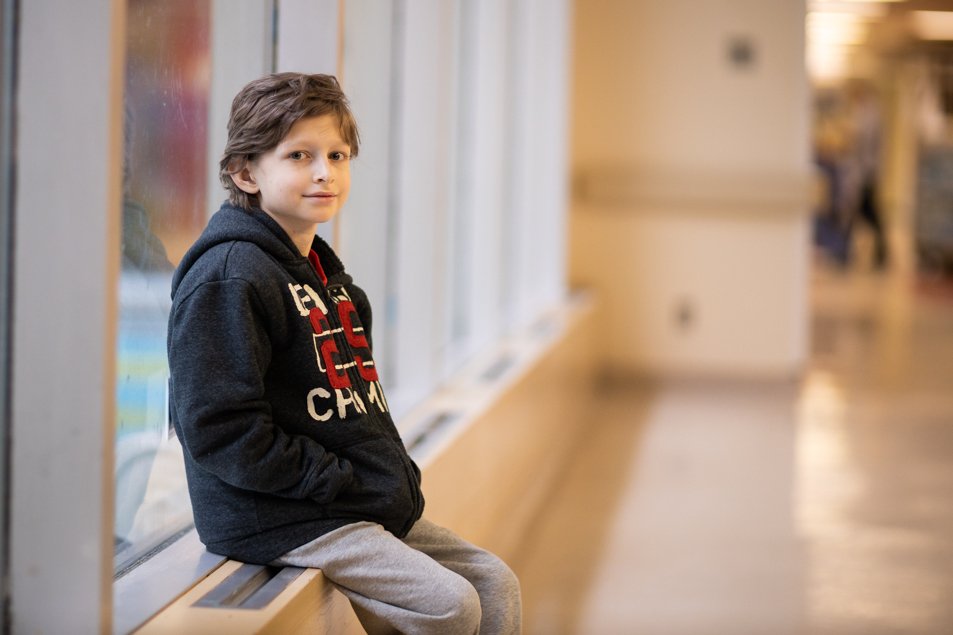
A lifelong battle with cancer at the age of eight
Eight year old Matthew Bueckert loves Lego, climbing trees, and playing tag and ball hockey. He especially loves when he gets to go to school, which unfortunately, isn’t as often as he’d like. Matthew is battling leukemia.
When Matthew was two and a half, he had terrible unexplained fevers on and off for a month. His pediatrician suspected cancer, and referred him to McMaster Children’s Hospital (MCH) right away.
“My heart sank,” says Valerie Bueckert, Matthew’s mom.
Matthew’s care team at McMaster Children’s Hospital explained to his parents the test results, the disease and treatment options, which included a clinical research trial.
Advancing treatments for childhood cancer
MCH is part of Dana-Farber Cancer Institute Acute Lymphoblastic Leukemia Consortium, which includes 11 North American institutions as well as the Children’s Oncology Group, made up of over 200 children’s hospitals from across North America and beyond. As part of these groups, MCH teams works with other hospitals on clinical trials to advance cancer care in children.
“Working with other hospitals allows us to find better treatment options for our patients.”
“Working with other hospitals allows us to find better treatment options for our patients,” says Dr. Uma Athale, Matthew’s oncologist at MCH. “Through another partnership with the Dana-Farber Cancer Institute Acute Lymphoblastic Leukemia Consortium a trial was available for patients with the exact leukemia Matthew has. We were offering it to our patients, so we presented it to his parents as an option.”
There are many different types of childhood cancers, and some of them are quite rare. For that reason, each individual hospital doesn’t see enough cases of each type to run a clinical trial alone. With hospitals working together, children can participate clinical trials that otherwise wouldn’t be available to them. This has helped childhood cancer survival rates increase drastically.
Considering a clinical trial
“The idea of a clinical trial was a little scary at first,” says Valerie. “The first thing that came to mind is that I didn’t want my child to be the guinea pig. But, on the other hand, why wouldn’t we want access to a treatment that may be better.”
The family learned that if a patient enters a clinical trial and they continue to worsen, they are not required to continue and can be switched to the standard of care treatment at any point in time.
Since leukemia can progress rapidly, it was important for Matthew to begin treatment as soon as possible. That meant his parents needed to make a decision quickly. It’s entirely up to the patient and family to select a clinical trial treatment method.
“We could have flipped back and forth on a decision for weeks, but since we only had a couple days we really focused on the facts,” says Valerie. “When it came down to it, the clinical trial wasn’t that much different than the standard of care and it had the possibility to be more effective. So, we went with the trial.”
It’s entirely up to the patient and family to select a clinical trial.
After the 25 month trial, Matthew went into remission at the age of four. He was back to his outgoing self.
Two years later, Matthew’s white blood cell counts started dropping and eventually the fevers returned.
“Matthew was under the watchful eye of McMaster Children’s Hospital, so when the same symptoms started to return we all jumped into action,” says Valerie.
Matthew’s leukemia had officially returned in December of 2017.
Hopeful despite a relapse
“The original clinical trial Matthew took part in provided conventional chemotherapy with slight variations. When he relapsed, we needed to consider a different, more targeted type of treatment,” says Dr. Athale.
There was another clinical trial available to MCH patients as part of the Children’s Oncology Group that included targeted immunotherapy. Immunotherapy works with the immune system to fight off the cancer cells. It is customizable, which made it a good fit for Matthew.
“Because of the immunotherapy component we said yes right away to this trial.”
“Since the last trial was so similar to the standard of care we knew another trial was the best option to go with this time around,” says Valerie. “Because of the immunotherapy component we said yes right away to this trial.”
Matthew is now just over half way through his treatment. When he’s feeling well enough, he goes to school and plays outside no differently than his older siblings and friends.
“For now, no news is good news, because it means nothing concerning has shown up in his test results. Although each day can be different, we’ve been happy to enjoy the good days,” says Valerie.
Thanks to the great support of Matthew’s team at MCH, the whole family is staying positive and hopeful.
